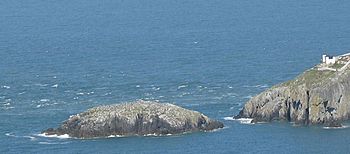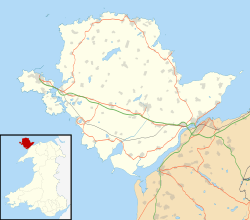North Stack facts for kids
|
Native name:
Ynys Arw
|
|
|---|---|

North Stack (centre), with a building from the defunct fog warning station (right)
|
|
| Geography | |
| Location | Anglesey, Wales |
| Coordinates | 53°20′00″N 4°41′00″W / 53.333332°N 4.683333°W |
| Administration | |
|
Wales
|
|
| County | Anglesey |
| Demographics | |
| Population | 0 (uninhabited) |
North Stack is a small island located off the coast of Holy Island in Anglesey, Wales. In Welsh, it's called Ynys Arw, which means "rugged island." This name perfectly describes the island's wild and rocky look.
Contents
The North Stack Headland
North Stack isn't just an island; it's also the name of the rocky piece of land, or headland, right across from the island. This headland has a lot of interesting history and activities.
Old Fog Station
Years ago, this headland was home to a special station. This station used to warn ships about fog. It had several buildings, including the Trinity House Magazine. This building was built in 1861. It was used to store special shells for a loud cannon. The cannon would fire to make a warning sound in foggy weather.
Today, these old buildings have new uses. One part is now a great place for birdwatching. From here, you can see the South Stack lighthouse across Gogarth Bay. Another building is now the art studio of an artist named Philippa Jacobs.
Amazing Rock Climbing
The cliffs at North Stack are made of a very strong rock called quartzite. These cliffs are very old, formed in a time called the Precambrian era. They offer some of the best rock climbing routes in Britain!
Climbers from all over the world come here. They challenge themselves on famous routes like "A Dream of White Horses" and "The Bells! The Bells!" People have been climbing here since the 1970s. Famous climbers, like Paul Pritchard, have even created many new and difficult routes on these cliffs.
Historical Plane Crash
North Stack was also the site of a sad event during World War II. On December 22, 1944, a B-24 bomber plane from the US Eighth Air Force crashed here. Sadly, all eight crew members on board lost their lives in the accident.
Images for kids





